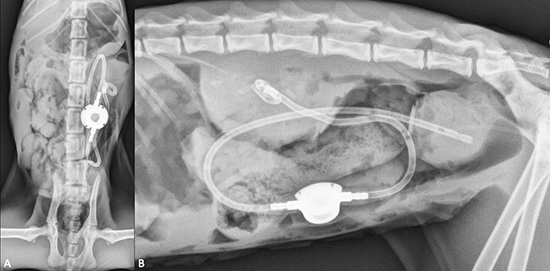Artificial ureter implanted in kitten will test device’s longevity

Post-surgery x-rays show two views of the SUB implant in the patient.
Subcutaneous ureteral bypasses (SUB) have been performed in adult canines and felines but not in younger patients, a spokesperson at the University of California, Davis (UC Davis), told NEWStat. Because of that, the longevity of the device has never been an issue.
Until now.
On March 3, UC Davis announced the successful implant of a SUB in a 17-week-old spayed female sphinx. Given the age of the patient, time will tell if the device will remain effective.
When the patient was brought to UC Davis, ultrasound revealed an obstruction of the left ureter that was preventing the flow of urine to the bladder but not the cause. After opening the patient’s abdomen, the veterinary surgeons discovered a traumatic stricture (scarred down area) present around the ureter, preventing it from being open.
Bypassing the natural ureter, the UC Davis surgeons created two distinct ends of a new ureter with tubing, one end coming from the kidney, one end leading into the bladder. The two pieces were connected with a titanium shunting port that was placed just under the skin for easy access for collecting urine samples from the system.
While the patient’s abdominal cavity had to be opened to perform the surgery, the implant was placed minimally invasively, utilizing interventional radiology to help guide the procedure.
The patient recovered without complications and post-surgery tests showed normal kidney function.
“Because the device has never been tested, [the patient] will require monitoring over time to insure the device is still working properly,” a spokesperson with UC Davis told NEWStat.
Photo credit: University of California, Davis



